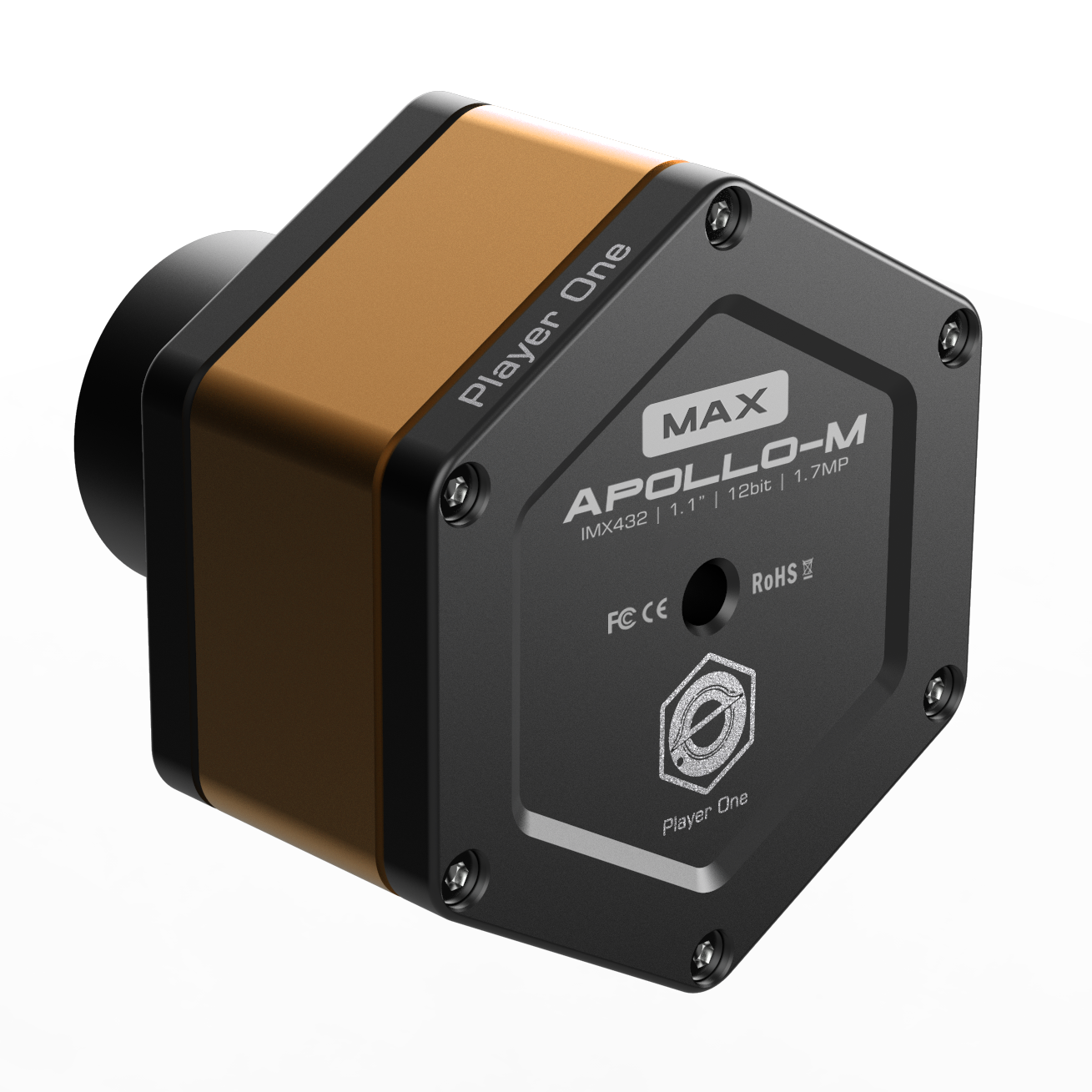Product Description
Apollo 428M MAX camera is a new solar camera developed by Player One Astronomy, which adopts the Sony IMX428 1.1” format monochrome sensor. The 4.5um pixel size accommodates a well depth of 25.3ke with a total of 7.1MP (the resolution is 3216*2208), and the diagonal is 17.5mm.

Pregius Technology
Apollo 428M MAX (IMX428) is based on Pregius 3rd Generation. IMX428 is a high resolution version of IMX432, it has 4.5um, and full well is 25Ke. But if you use BIN2 mode, IMX428 will has 9um pixel and of course the full well up to 4x (100Ke).
Format
Apollo 428M MAX (IMX428) has 1.1″ format, same as Apollo-M MAX. It is pretty big, almost twice of IMX174 chip.

Pixel size
4.5um pixel size is half of IMX432 camera, which means it will have 4X resolution than classic Apollo-M MAX camera.

Interesting BIN Mode
As we know Apollo 428M MAX Pro has 4.5um pixel size, half size of Apollo-M MAX. If we use bin2, it will more like an Apollo-M MAX, and 3 conbination bin mode will have some advantages:
MONO8 hardware BIN2 mode: full well up to 4x (100Ke), 10bit ADC, FPS will up to 135FPS.
MONO16 hardware BIN2 mode: full well up to 4x (100Ke), 12bit ADC, FPS will up to 109FPS.
MONO16 Software BIN2 mode (sum mode): full well up to 4x (100Ke), date bit depth up to 14bit, FPS will stay at 27FPS.
HCG and Noise
HCG mode will automatic open when Gain ≥70, readout noise will drop to 2.4e. And dynamic range will rise to 12 drops again.
At 450 gain, readout noise of Apollo 428M MAX (IMX428) camera is 1.4e.
Highlights
New Solar Ha imaging and post-processing tutorial (Demonstrate with Apollo-M MAX)
No banding
Row noise problem is a big trouble in solar imaging. When we use IMX174 or IMX178 cameras, bandings occurs sometimes. Although we can make it slight in post-processing, but it still does negative affect on the details.
The biggest surprise in testing Apollo 428M MAX is, we found that images of IMX428/432/429 are so smooth, no annoying horizontal banding. So that, we can focus on capture details in any focal ratio, in any way ( full disk mosaic or ROI ) , never need to worry about banding issue in post-processing.

With global shutter,Apollo 428M MAX are very suitable for sun and space station imaging.

“The official recommended camera of The Charlie Bates Solar Astronomy Project“
Recommended accessories:
ACS (Active Cooling System)
ACS is a external air-cooled system, designed for solar and big format planetary cameras which already has PCS (Passive Cooling System). ACS can provide much better temperature control. When camera has PCS + ACS, temperature is only 7℃ higher than ambient, camera body is a little warm but won’t hot! ACS is not only can be used in daylight for solar imaging, it also could be used in night for DSO lucky imaging.
https://player-one-astronomy.com/product/active-cooling-system-acs-for-uncooled-cameras/

User reference images:
The Sun in White Light
For better contrast, Player One Photosphere 10nm filter will be a good choice.

Demonstrate with ES127APO:

The Chromosphere in H-Alpha
Introduce new 1.25″ ERF filter for Quark Chromosphere (Ha verstion) , intend to reject energy and extend life time of your Quark.

Demonstrate with 80APO + Quark Chromosphere:

Features:
The naming of Player One Astronomy cameras is unique. Solar camera line, named after Apollo, the god of the sun. The suffix of the name describes the camera’s biggest feature.
Drivers and softwares download: http://player-one-astronomy.com/service/software/
Manuals download: http://player-one-astronomy.com/service/manuals/
2nd Gen – Sensor Tilt Plate
When taking solar photograph with prominence telescope, the Newton ring is annoying. Smoother solar image without Newton ring could be taken by adjusting the focal plate. Get a much smaller field curvature of the telescope.

The built-in high-density sponge shading pad can block the light from the side slits without any side leakage.


Passive Cooling System
Solar cameras working in daylight, temperature could be much higher than night. Heat of global shutter sensors will be a problem, especially some big format like IMX428. Player One add one new feature called Passive Cooling System to conduct the heat from the sensor out.

256M DDR3 Cache
Player One Astronomy cameras are the first one who adpots the DDR3 cache in all planetary cameras in the world! It helps stabilize and secure data transmission, it effectively avoids frame dropping and greatly reduces readnoise.
With the DDR3 cache, the camera does not have high demands on computing needs any longer, it will still has excellent performance even if it is connected to a USB 2.0 port.

DPS technology
The planetary cameras from Player One Astronomy have DPS (Dead Pixel Suppression) technology. The DPS is anaylse many dark frames to find out thoes fixed abnormal pixel and record the map in camera memory. In imaging, each exposure frames, thoes position of dead pixels will be given a median value according to the active pixels around that abnormal pixel.

Overvoltage and overcurrent protection mechanism
Player One cameras produced by the number one player ensures the safety of your camera and other equipment through overvoltage and overcurrent protection mechanisms.
Data Port
When the camera is connected to the USB3.0 interface and full-resolution preview is used, it can reach 51FPS at 10bit(RAW8) mode and 27FPS at 12bit (RAW16) . When recording images, since the actual writing speed will be affected by the writing speed of the hard disk itself, when the hard disk writing speed is slow, the recording may not reach the theoretical speed. It is recommended that you use a high-quality solid state drive to record data to give full play to the performance of the camera.
Use the ST4 guide cable to connect the camera and the AUTO GUIDE port of the equatorial mount to do guiding.

Performance

Readout Noise
Regarding readout noise, we solemnly promise that all values are obtained from actual tests. And for users, you could use Sharpcap 4 for testing. SC4 has a function called Sensor Analysis, provide a very simple way to test readout noise.
We wrote a tutorial on our website: https://player-one-astronomy.com/service/manuals/
After many rigorous readout noise tests, this camera can reach a low readout noise of 1.4e at a gain of 450.
If you are interested in readout noise testing, you may try it yourself, which is very simple.
QE Curve

HCG Mode
The Apollo 428M MAX camera has a unique HCG mode, which will automatically turn on when the camera gain setting is >=70. The HCG mode can greatly reduce the readout noise and retain the same high dynamic range as the low gain.
Mechanical Drawing










